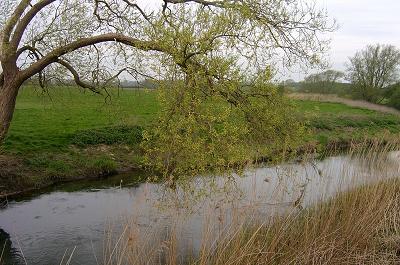Cricklade to Kempsford
The addition of the waters of the River Churn to the Thames below Cricklade suddenly increases both the depth and the width of the river. This increases again shortly afterwards with two more tributaries, the River Key and the River Ray making their contributions to the expanding flow. Within a short walk of Cricklade the river and its associated surroundings move up the scale by a few notches. Footbridges become taller and longer, and it would be a foolhardy walker who now tried to leap between the banks as was possible for most of the previous day.
The pathway follows a succession of footbridges that cross over the many water channels that discharge their flows into the main river. I pass through water-meadow after water-meadow and cross bridge after bridge as the river widens and deepens over the next four miles.
Without warning the track suddenly veers away from the river towards the village of Castle Eaton. As I approach the village I- look in vain among the rows of stone cottages for the castle, but I am assured that there isn’t one.
The path leaves the riverside for a while and uses narrow lanes before rejoining the river near Kempsford. This is one of those places that defy all logic when you look at its history. Here we are in Wiltshire, and yet in medieval times the village was a part of the Duchy of Lancaster. Even with the technology we have at our disposal today for anyone to attempt to administer a village from almost the other end of the country would prove to be what the management gurus like to term “challenging”. So how did they do it in the 14th century with none of the communication services we take for granted these days? Mind you, the messenger service in those days was probably still quicker than the post office is today, so perhaps they had some advantages after all.
Kempsford gained by its association with Lancaster when John of Gaunt arranged for the building of a new church tower. He commissioned the construction of the tower to be a memorial to his late wife, and it was completed in 1390. Again, imagine for a moment the difficulty that this must have involved in those days. Anyone who has had the builders in can relate many tales of frustration with their timekeeping and progress of the job. How did John of Gaunt “keep an eye” on the builders from his northern homeland?
 Thames Downstream of Crickslade
Thames Downstream of Crickslade
After a short meeting with the river, the pathway separates again and follows a wide bridle path to Inglesham. The river is mostly hidden from my sight during this part of the walk, but reassuringly still lays only a couple of fields away to my left, taking its own lonely route in parallel to the pathway.
This is the longest section that I will experience on the entire walk where the pathway does not run alongside the riverbank. The bridleway is a pleasant enough walk, but I stride purposely onwards towards Inglesham, where I will rejoin the river to travel together once more.
Next Page >